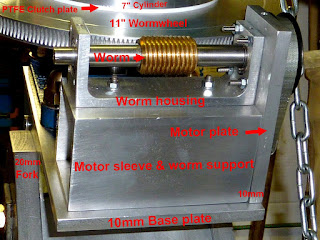*
I keep looking for a better way to lock the end of the worm housing firmly to the upright motor plate. The motor plate has a large 32mm hole to clear the pulley boss. Which leaves very little room for screws in the end of the worm housing's channel profile. Which is itself perforated with a large hole for the worm shaft bearing.
There is also very little clearance on the wormwheel side. So adding an extra [stepped] plate to trap the worm housing would not work unless it was made highly asymmetric.
I could use lengths of threaded rod to hold the motor to the far end of the sleeve. This would stabilize the worm support sleeve. Though I'd still need to pin the worm housing to the motor plate to stop it moving laterally. Pins take up much less room than 4mm screws.
 An alternative would be
to turn down the pulley boss and make yet another new motor plate.
There are now three grub screws in each pulley boss instead of the
original one. So the pulley's grip on the worm shaft should be assured
even if the screws were inevitably shorter in a smaller diameter boss.
Particularly if the worm shaft is 'dimpled' to locate the tips of the
grub screws.
An alternative would be
to turn down the pulley boss and make yet another new motor plate.
There are now three grub screws in each pulley boss instead of the
original one. So the pulley's grip on the worm shaft should be assured
even if the screws were inevitably shorter in a smaller diameter boss.
Particularly if the worm shaft is 'dimpled' to locate the tips of the
grub screws.Slots for the fixing screws in the edges of the worm housing profile would minimize the impact of the screw holes. Nyloc nuts with washers would ensure stability. Though the screw heads would need to be sunk into the motor plate due to the close proximity of the pulley rim. Counter-boring the motor plate for socket head screws would be no problem.
After much scribing and measuring I finally drilled holes in the end of the worm housing. I then used a long pointed rod to spot the motor plate through the bearing housing holes. The holes for the fixing screws were counter-bored to 7mm to sink the ss, hex, socket-head screw heads flush with the front of the motor plate. This was to allow clearance for the pulley rim which lies very close to the motor plate for maximum, worm shaft depth in the large pulley. The screws are still too long but that is easily fixed. I shall use washers and Nyloc nuts once I am completely happy with the construction.
The worm and motor are now firmly attached to each other via the 10mm thick motor plate. The base plate is solidly held by the axis bearing flange and the four 16mm studs which run the length of the PA bearing housing. The worm is bolted onto the top of the motor sleeve which is itself bolted down to the base plate. The plate fixing screws are now increased to 6mm. I have yet to increase the diameter of the worm fixing screws onto the sleeve.
Click on any image for an enlargement.
*
No comments:
Post a Comment